The highest mountain in Alaska is Denali, also known as Mount McKinley. This mountain’s point is 6,190 meters above sea level, so you’d imagine that there aren’t that many things living up there. However, nature always finds a way. You can find many different animals on Alaska’s tallest mountain, though many of them may not reach the very top. The mountain is the center of the Denali National Park, so the area is protected.
It’d be impossible to describe all of the animals that live in the park. There are over 160 species of bird alone, for instance. However, below, we will discuss some of the most popular and abundant animals on Alaska’s tallest mountain.
1. Grizzly Bear
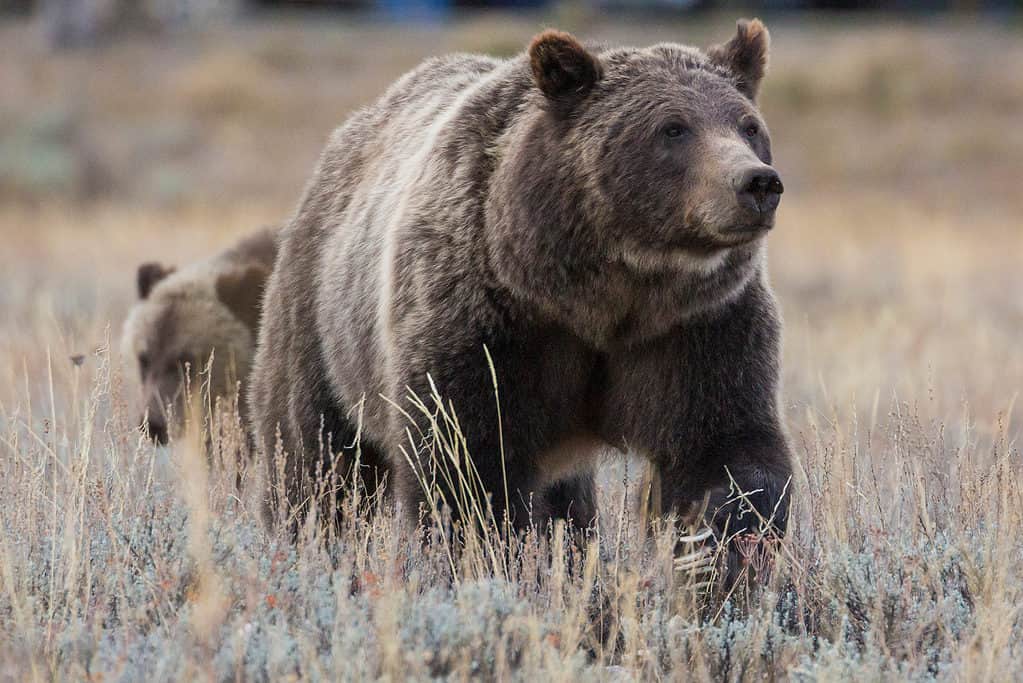
Grizzly bears are one of the biggest animals on Alaska’s tallest mountain.
©BlueBarronPhoto/Shutterstock.com
Grizzly bears are one of the more popular Denali animals. Despite being massive predators, these bears aren’t a huge risk to humans. They’re a type of brown bear with a distinctive hump on their shoulders and extremely long class.
These bears are omnivores, meaning they consume a range of plant and animal matter. They’re known for consuming grasses, berries, roots, fish, and small mammals. Occasionally, they may prey on caribou and moose.
For the most part, grizzly bears are solitary. However, the cubs will stick with their mother for about two years. They can weigh up to 600 pounds, but their weight does fluctuate throughout the year.
There are about 300 to 350 grizzle bears on the north side of the Alaska Range, where most visitors go. Usually, they’re seen in close proximity to areas of abundant food, such as berry patches.
2. Moose
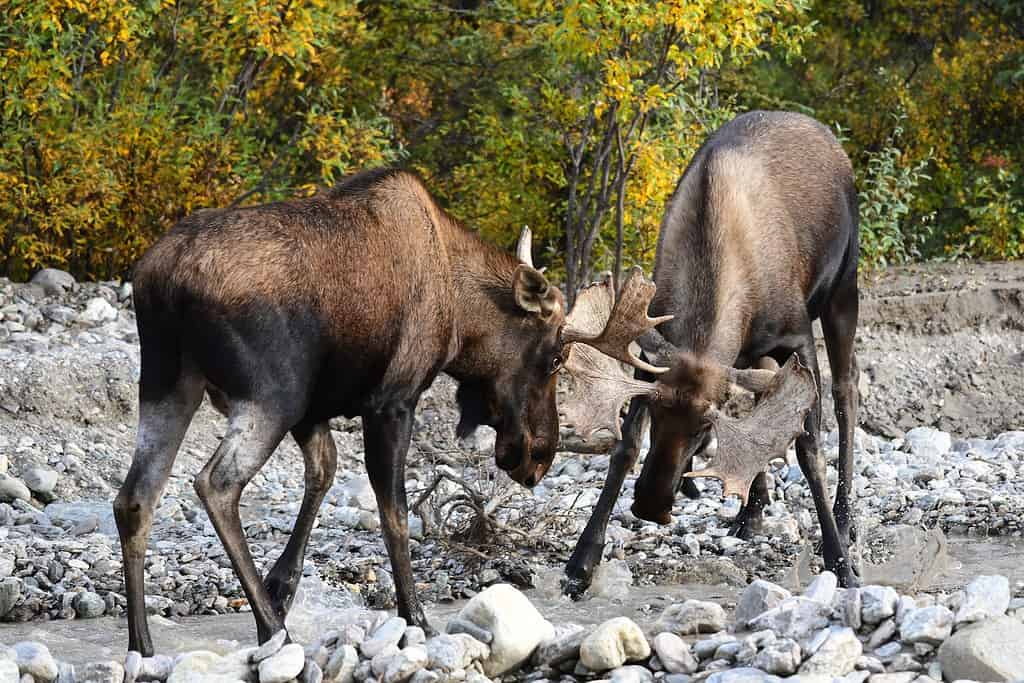
There are around 1,800 moose on Denali, Alaska’s tallest’s peak.
©JT Fisherman/Shutterstock.com
The moose is the largest member of the deer family, weighing up to 1,400 pounds. They are extremely tall and stand at 5 – 6 1/2 feet at the shoulder. They use their long legs to wade through water and eat plants off the bottom, which is one of their main food sources.
As herbivores, moose consume grasses, forbs, underwater vegetation, bushes, coniferous needles, and deciduous leaves. They eat a surprising variety of plant matter, not being nearly as picky as many other animals.
According to the National Park Service, there are about 1,800 moose on the north side of the Alaska Range.
3. Caribou
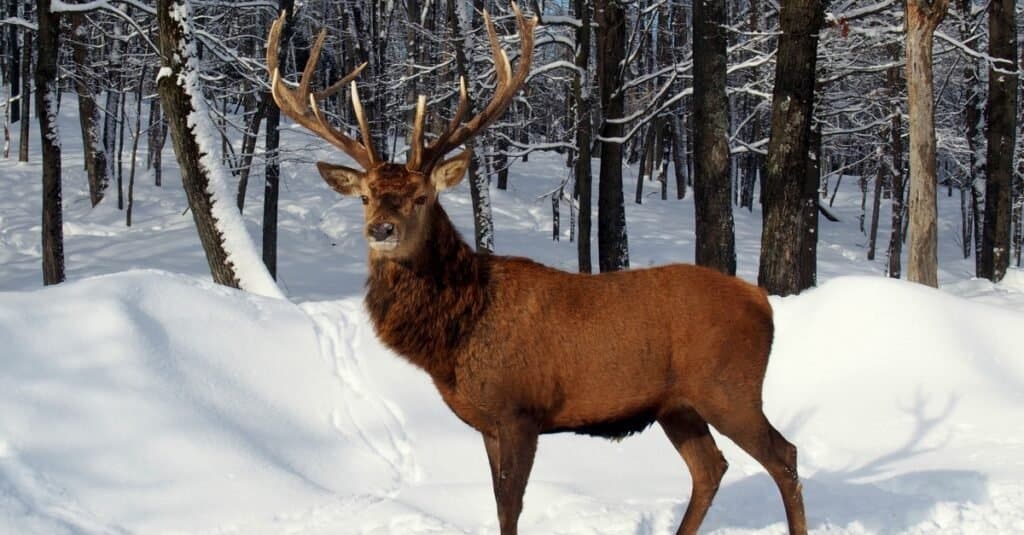
The Denali animals herd also includes caribou, migratory deer with large antlers.
©Nick Couckuyt/Shutterstock.com
Caribou are another type of deer. They have fairly large antlers that span up to 6 feet across. For comparison, that’s about as long as moose antlers.
As they were designed to live in snowy, cold conditions, these caribou have thick coats of brown fur (though it turns grayish in the winter). Their large hooves may look threatening, but they help them walk across the snow without sinking – a bit like snow shoes.
These animals are herbivores, so they consume grasses, lichens, mushrooms, willow leaves, and forbs. They will also eat certain roots, especially when food is scarce.
There are around 2,000 caribou in the Denali Herd, which stays almost exclusively within the park boundaries. Because these animals are migratory, they move around a lot to find food.
4. Dall Sheep

A type of wild sheep known as Dall sheep roam Denali Park, surviving the cold with their thick wooly coat.
©iStock.com/photoak
Dall sheep are a particular kind of wild sheep that have very thick wool. For the most part, they’re native to colder areas, and their wool helps them stay warm.
They consume grasses, leaves, lichens, and forbs. (However, they are not extremely picky and have been known to eat all sorts of things.)
There are several thousand Dall sheep in the park. However, most of them are in the eastern and western regions. They live mostly in the high mountains, using ridges and sloops to avoid predators. They’re a bit like mountain goats in this regard.
These sheep aren’t as common as many of the other Denali animals we’ve discussed, so they’re much harder to spot.
5. Wolves
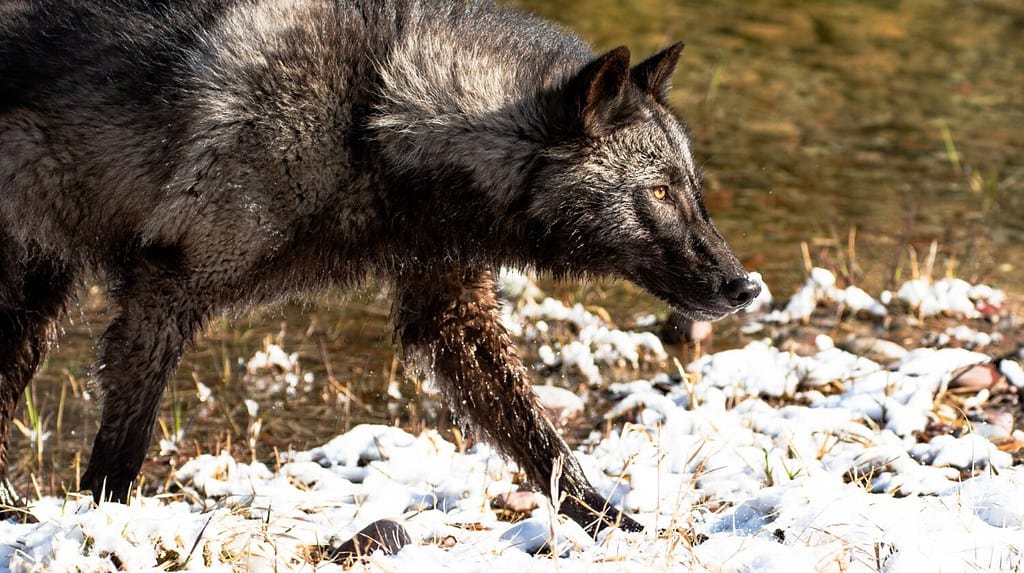
Around 100 individual wolves roam Mount McKinley.
©Wirestock Creators/Shutterstock.com
You’ll also find a decent number of wolves among the Denali animals. There are about 100 individuals in the area divided between 12 to 23 family groups. Each group has its own territory that they defend from other wolves.
The odds of seeing a wolf are best in the 50 first miles of road at the park’s entrance. This road goes across the territory of two packs, doubling your chance of seeing the wolves.
Wolves are carnivores and hunt mostly small game. However, they may also eat moose, caribou, and Dall sheep. They hunt in packs, which makes it easier for them to take down larger prey.
Wolves are very social animals and communicate with each other all the time.
6. Collared Pika

The collared pika is well-adapted to the cold weather and doesn’t hibernate.
©NancyS/Shutterstock.com
Visitors may rush to see bears, wolves, or caribou, but you probably won’t see many talking about the collared pika. However, you should keep a lookout for this animal in the park, too.
Collared pika are small animals related to rabbits and hares (though they look more like small rodents). They have short, round ears and a light circle of fur around their neck (their “collar”). They grow to about 7 inches long.
These animals are herbivores, feeding on grasses, lichen, and whatever else they can find. They live in rocky outcrops and boulder fields with lots of individual rocks. Unlike many similar species, they do not hibernate.
Their lack of hibernation does lead to some strange behavior. They gather vegetation throughout the summer, laying them out so that they dry in the sun. Then, they store these piles of hay underneath rocks. They may even store toxic plants, like Alpine avens, and wait to eat the plant until the chemicals have broken down.
These animals are surprisingly social and live in colonies. Seeing several scampering around and checking on their drying plants is quite a sight. They communicate with each other using high-pitched squeaks.
7. Hoary Marmot
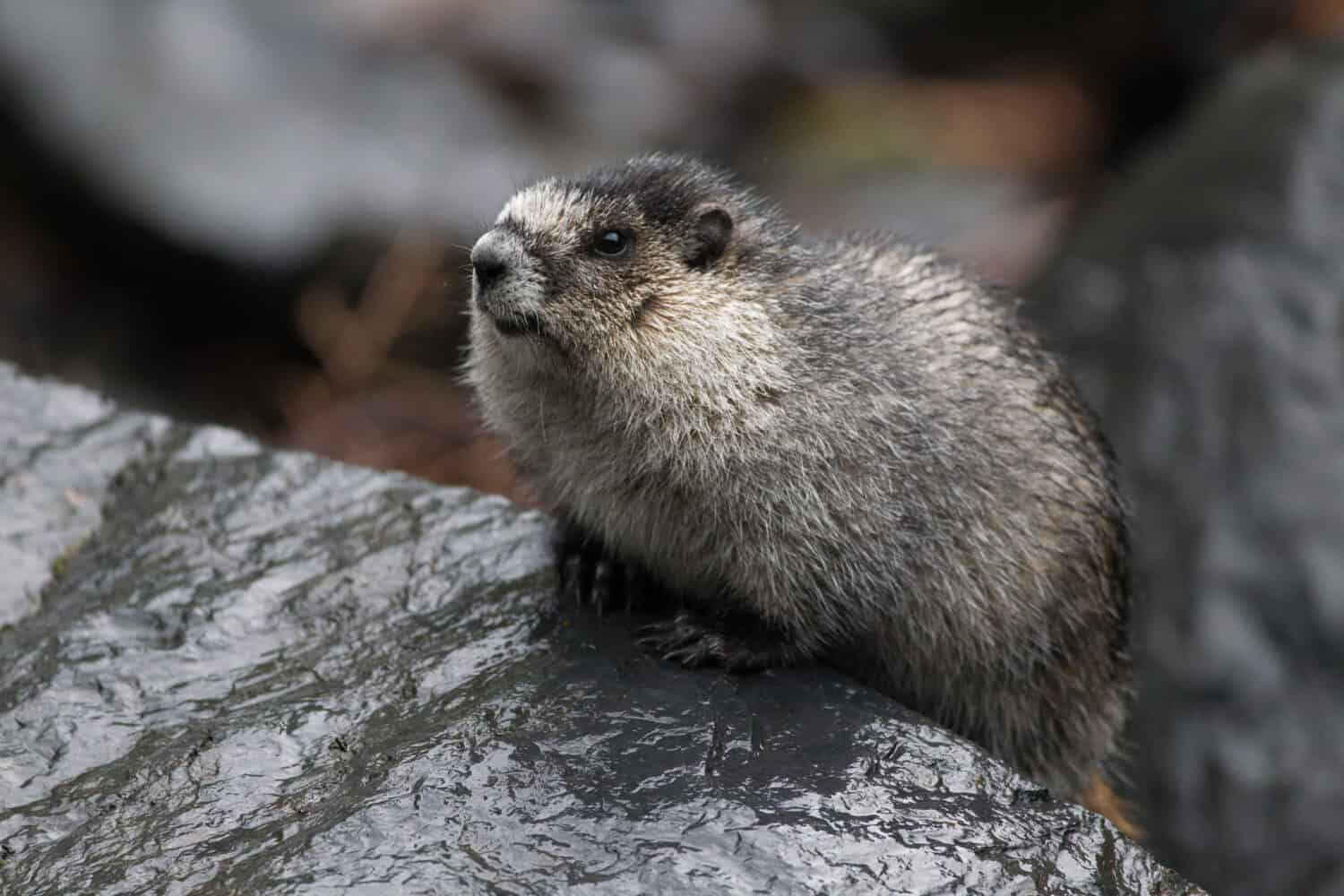
Hoary marmots live in mountainous areas.
©Alexandre Boudet/Shutterstock.com
The hoary marmot is basically a large rodent related to groundhogs and squirrels. They have an extremely thick coat that’s brown in the summer and gray in the winter. Their black feet and “collar” make them pretty easy to identify.
Despite being a rodent, hoary marmots are more similar in size to a house cat, weighing up to 30 pounds. (That’s quite a large rodent.)
They prefer to live in alpine tundra or rocky outcroppings, where they dig burrows. They’re strictly herbivores, consuming grasses, lichens, and leaves.
Hoary marmots live in loose colonies consisting of a dominant male with a few females and their offspring. They are highly sociable and groom each other, play, and sunbathe together. They remind me a bit of otters in their behavior – just without the water.
They have a whistle-like alarm that helps them alert each other to predators. Because of this alarm, they’re also called “whistle pigs.”
8. Red Fox
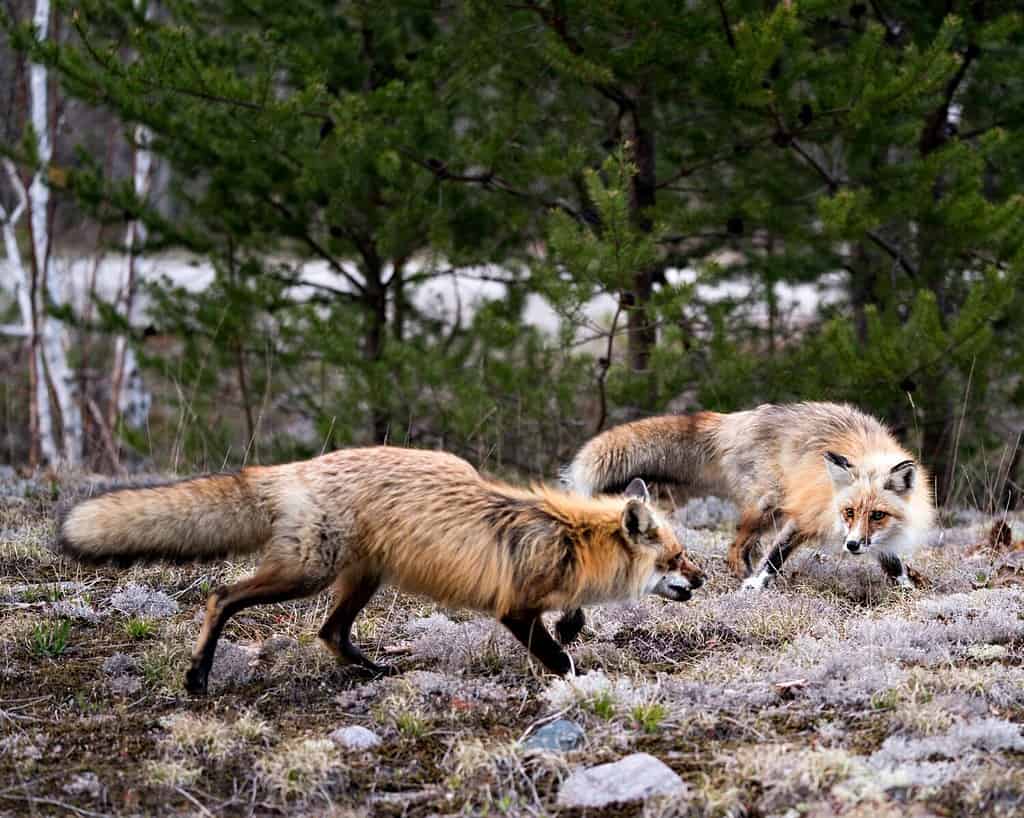
Red foxes live throughout North America, including on Denali/Mount McKinley.
©Rejean Aline Bedard/Shutterstock.com
Red foxes are common across much of North America, so it isn’t surprising that they’re among the animals on Alaska’s tallest mountain.
Despite their name, not all red foxes are red. They have different color schemes, including black, silver, and cross. It’s a bit confusing because the name “red fox” often misleads viewers into believing that all red foxes are red (which would make sense, wouldn’t it).
Red foxes are omnivorous and eat just about anything. They may consume birds, eggs, plants, small mammals, berries, and carrion. They aren’t picky.
If they find too much food, they will cache it in their den to eat later. Sometimes, they share this food with other foxes or animals.
Their sounds are very similar to others in the dog family, only higher pitched. They also have paws that look like cats, which is why they are often called the “catlike canine.”
9. Arctic Ground Squirrel
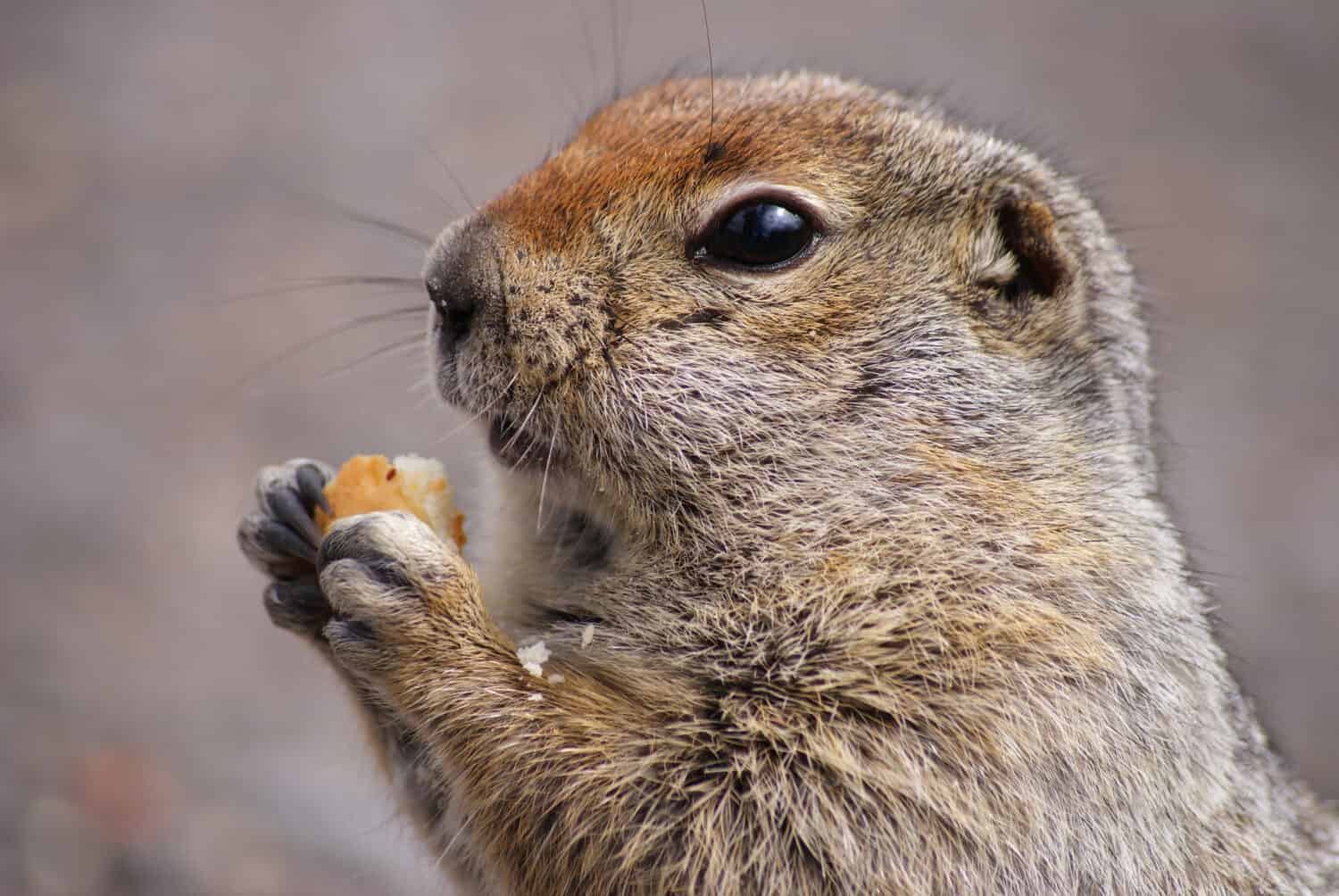
Arctic ground squirrels are the heaviest ground squirrels and can weigh up to 1,500 grams.
©Lateman/Shutterstock.com
These small rodents are related to other squirrels, as you might expect. They have very thick, brown fur that helps them stay warm. Their coat usually turns white in the winter. They’re a very common prey animal in the park, being targeted by wolves, bears, foxes, eagles, and owls.
Arctic Ground Squirrels are herbivorous, meaning they eat vegetation. They also live in burrows, choosing areas with well-draining soil. They hibernate in these burrows a lot – sometimes for up to 8 months.
They have the lowest body temperature (below freezing) ever measured in a mammal during hibernation. Scientists are still a bit confused about how they survive being so cold.
10. Snowshoe Hare
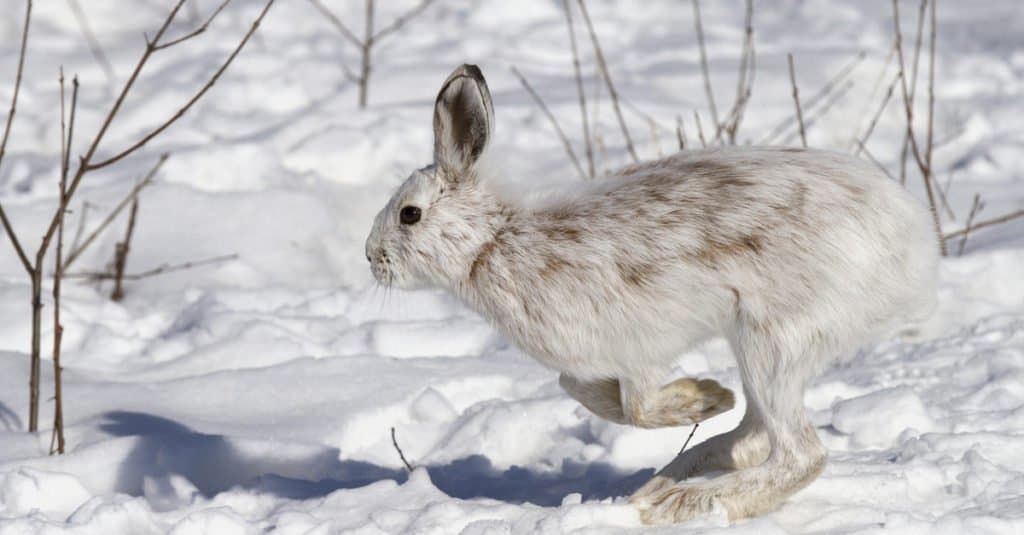
Snowshoe hares live on Denali and hide from various predators, however, they can blend well in the snow.
©Jim Cumming/Shutterstock.com
Hares are pretty common throughout much of the world, so it makes sense that one species, the snowshoe hare, would make its home in snowy Denali.
This hare has a thick coat of fur that’s white in the winter and brown in the summer, which helps them blend in. They have extremely large hind feet that work a bit like snowshoes, hence their name.
Like many hares, they are crepuscular, meaning they’re active mostly at dawn and dusk. Other times, they hide from predators under sheltering bushes or stumps. There are many predators that target them, including wolves, bears, eagles, and foxes. They rely on their speed, agility, and camouflage to stay safe.
Snowshoe hares have population cycles that last 8 to 11 years, alternating between periods of high and low density 12. These cycles affect the populations of their predators as well, especially the lynx.
11. Wolverine
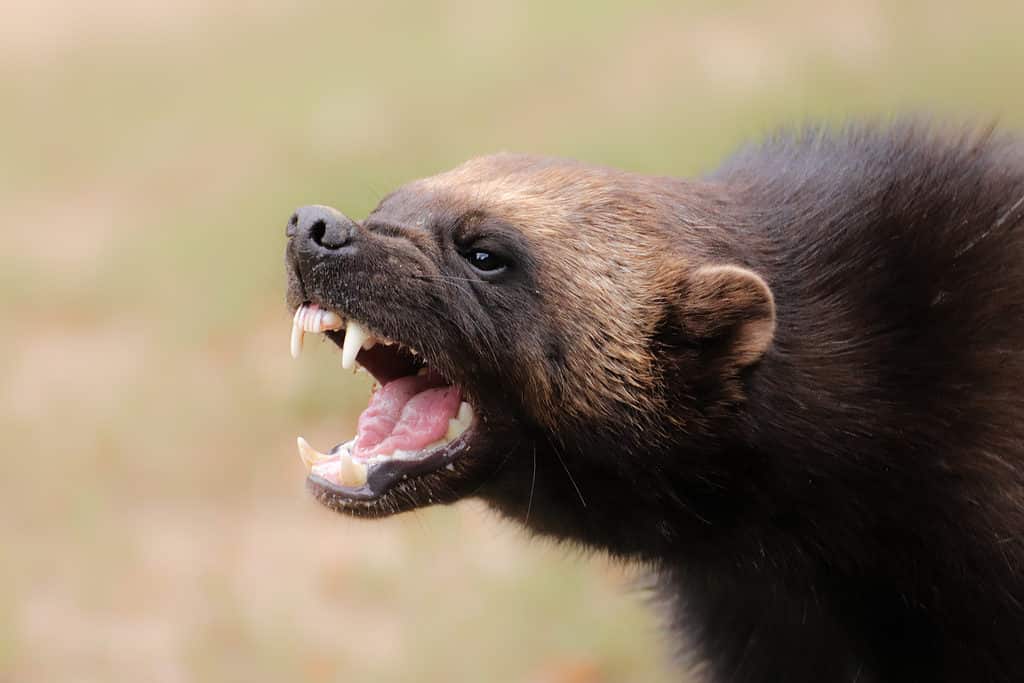
The feisty wolverine is one of Denali’s several carnivores.
©DenisaPro/Shutterstock.com
Wolverines are very feisty, powerful carnivores that belong to the mustelid family, which also contains weasels and mink. They are the largest member of this family in Denali, weighing up to 55 pounds. They are very large and not to be trifled with.
They have a thick coat of brown fur with a lighter stripe on their side. Their tails are typically very bushy.
Wolverines have very large home ranges of up to 800 square kilometers. They often follow traditional travel routes throughout their territory, though. They’re very much creatures of habit.
These mammals are extremely ferocious and will take down animals much larger than themselves, including moose. They have strong jaws that can crush bones and eat through frozen flesh.
Wolverines are very rare and elusive. They’re rarely spotted by experts. Therefore, they are very hard to study. They’re labeled as the least concern, but there isn’t much data to back that up.
12. Lynx
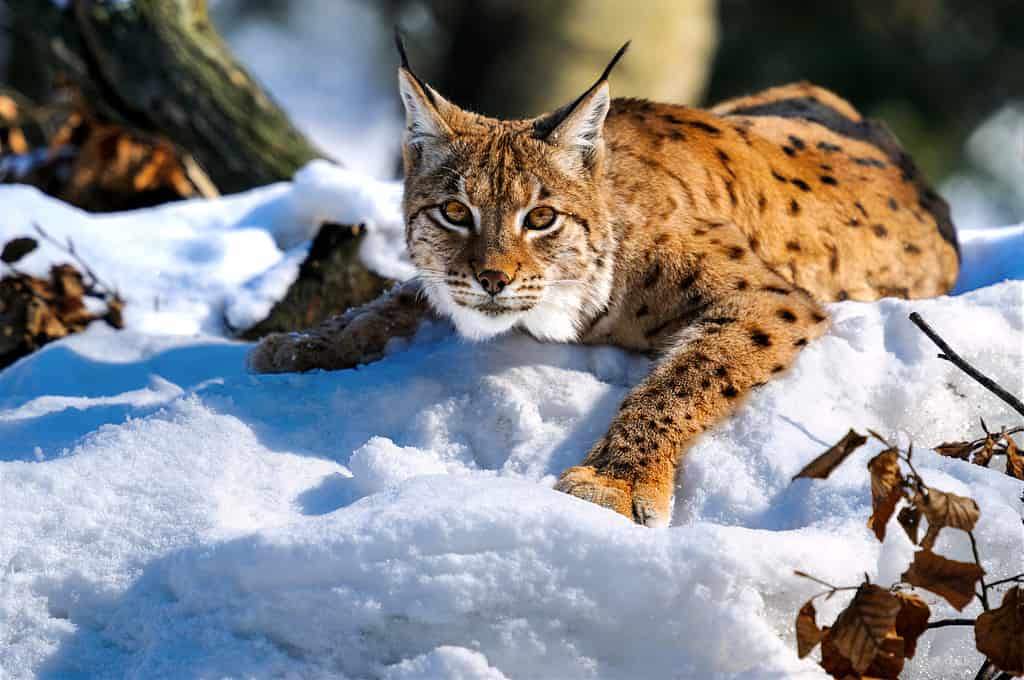
The lynx is an elusive wild cat that subsists on snowshoe hares, squirrels, and other creatures.
©iStock.com/Kyslynskyy
Lynx are the only native wild cat species located in Alaska. They’re found throughout the United States, including some islands. They have a thick, gray coat with black spots. Their large ears have black tufts, and their paws are much too large for their bodies. Like many animals on this list, these overgrown feet act as snowshoes.
They are strictly carnivores and eat mostly snowshoe hares; they will also consume squirrels and whatever else they can get their paws on. Lynx have population cycles that follow the cycles of their main prey, the snowshoe hare. When hares are abundant, lynx populations increase, and lynx populations decline when hares are scarce.
Lynx are another animal that is difficult to study, largely because they are very elusive.
13. Coyote
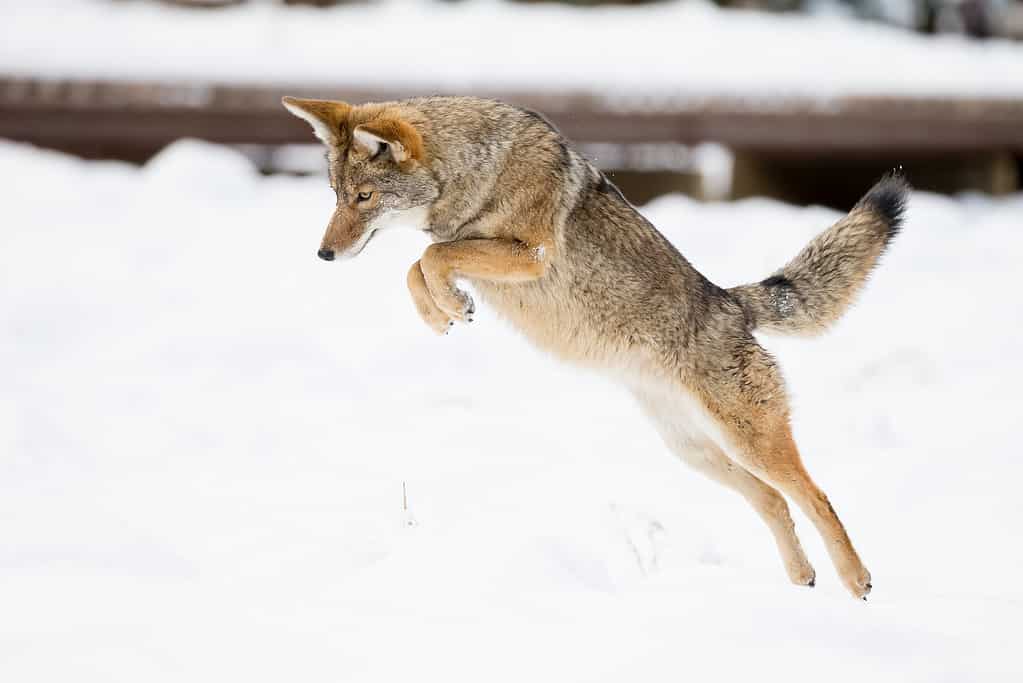
The coyote arrived in Alaska in the 1920s and thrives in Alaska just as it does in other parts of North America.
©Keneva Photography/Shutterstock.com
Coyotes are just about everywhere in North America, so it isn’t surprising that they are around Denali. However, they are a newer species to Alaska, arriving in the 1920s. They’re more common in the interior and southern parts of the state.
Coyotes are smaller than wolves but larger than foxes, typically weighing around 30 pounds. They’re omnivorous, eating whatever they can find. They most commonly consume voles, ground squirrels, and snowshoe hares. Occasionally, they may eat eggs, plants, and berries.
These small predators are extremely adaptable, which is why they are able to live across the United States.
14. Bald Eagle

The regal bald eagle is soaring through the air on Alaska’s tallest mountain.
©iStock.com/Schaef1
Bald eagles are the national bird of the United States. They’re large, powerful birds of prey that belong to the same family as kites, vultures, and hawks. They have a distinctive white head, which makes them look “bald.”
Bald eagles are protected by federal laws and international treaties that prohibit killing, harming, or disturbing them or their nests. They have recovered from near extinction thanks to conservation efforts and banning pesticides such as DDT.
They’re carnivores and consume mostly fish. However, they’re also known to eat other birds, small mammals, reptiles, and carrion. They have a wingspan of over 8 feet and can weigh up to 15 pounds, making them one of the largest birds.
15. Ptarmigan

Alaska’s tallest point includes more than 100 species of birds, including the ptarmigan.
©Troutnut/Shutterstock.com
The Ptarmigan is a type of small, plump bird that belongs to the grouse family, which also includes turkeys, quails, and pheasants. They’re ground birds with thick coats of feathers that change colors with the seasons.
There are three different species of ptarmigan in North America, and all of them are in Alaska. The willow ptarmigan is the most common species and is the state bird of Alaska.
Ptarmigans have feathered feet that act like snowshoes, allowing them to walk on snow and ice. The comb-like structure of their toes also helps them grip slippery surfaces, such as ice.
They’re very social birds and live in flocks of up to hundreds of individuals. They communicate with each other vocally and can make quite a racket.
16. Wood Frog
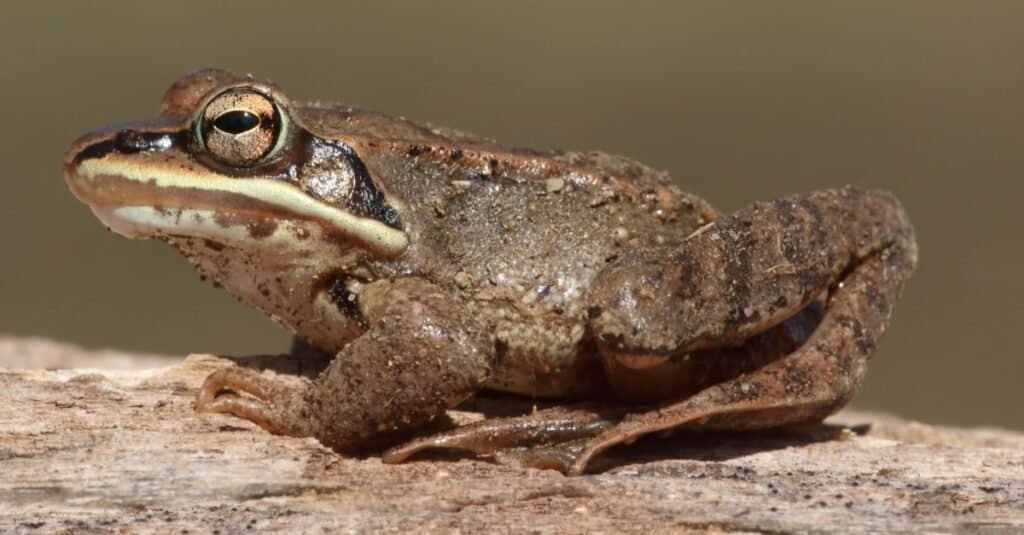
Only one amphibian, the wood frog, lives in these cold Alaskan conditions.
©Steve Byland/Shutterstock.com
The wood frog is the only type of amphibian in the park. It’s very cold in Alaska, so that isn’t surprising. Their special adaptation allows them to produce a natural antifreeze in their blood, preventing them from freezing in Alaska’s very cold conditions.
They hibernate through the winter under leaf litter or snow, waiting until the spring to thaw out. Once this occurs, they meet in breeding ponds.
Technically, they are omnivorous. However, they mostly consume insects, worms, snails, and slugs.
Plant Life at the Peak
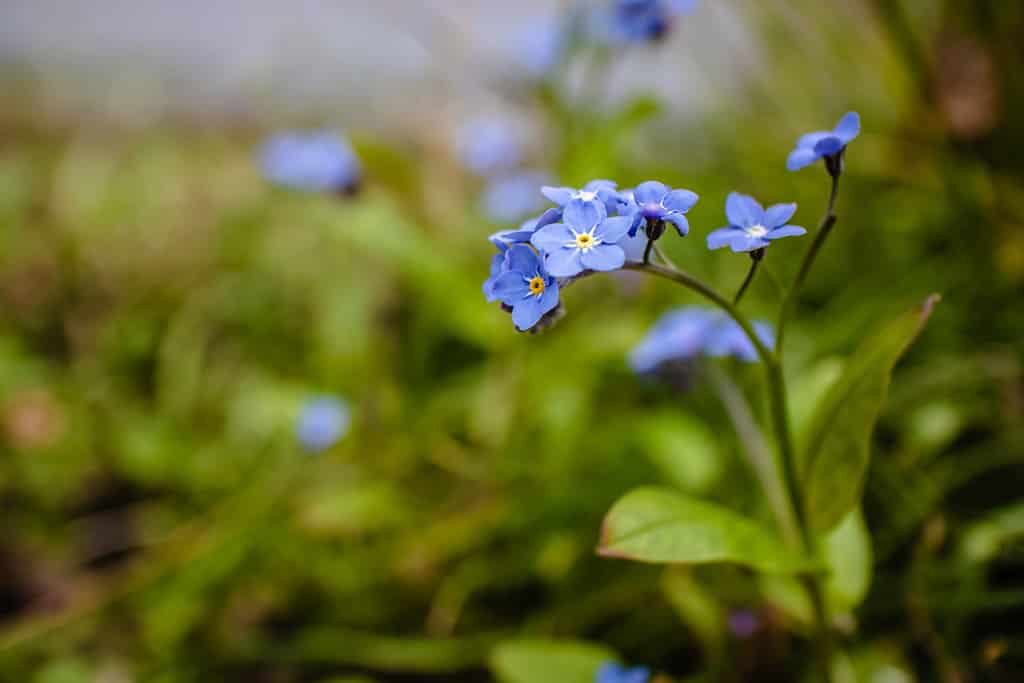
Alpine forget-me-not, the state flower of Alaska, grows on Denali.
©Oakland Images/Shutterstock.com
The plants that grow at the peak of Denali are alpine plants that can survive harsh conditions like cold, wind, and drought. These plants often have special adaptions and grow very close to the ground. Hairy leaves, thick cuticles, and deep roots are common.
Moss Champion is one such plant. It’s a small, pink-flowered plant that forms dense cushions on the rocky slopes of Denali. You may also spot Alpine forget-me-not, which is a tiny, blue-flowered plant that grows in gravelly areas. It’s also the state flower of Alaska.
Alpine azalea is also common. This shrubby plant has white flowers and grows in the moist tundra. Their sticky leaves trap insects for extra nutrients, which can be hard to get in alpine areas.
Dwarf fireweed is a magenta-flowered plant that grows in dry meadows. It has a taproot that reaches up to 6 feet deep.
The photo featured at the top of this post is © NancyS/Shutterstock.com
Thank you for reading! Have some feedback for us? Contact the AZ Animals editorial team.






